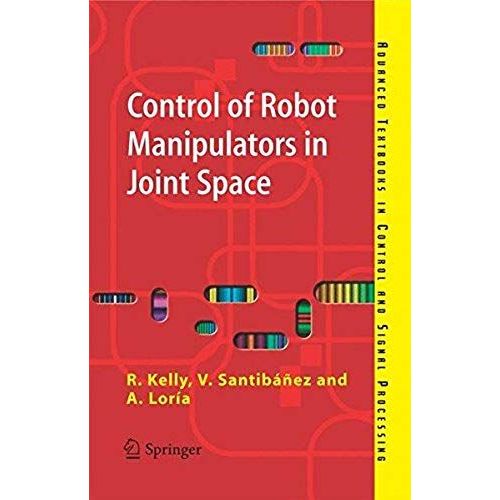

Control of Robot Manipulators in Joint Space -
- Format: Broché Voir le descriptif
Vous en avez un à vendre ?
Vendez-le-vôtre37,79 €
Produit Neuf
Ou 9,45 € /mois
- Livraison à 0,01 €
- Livré entre le 2 et le 5 août
- Payez directement sur Rakuten (CB, PayPal, 4xCB...)
- Récupérez le produit directement chez le vendeur
- Rakuten vous rembourse en cas de problème
Gratuit et sans engagement
Félicitations !
Nous sommes heureux de vous compter parmi nos membres du Club Rakuten !
TROUVER UN MAGASIN
Retour

Avis sur Control Of Robot Manipulators In Joint Space de Collectif Format Broché - Livre
0 avis sur Control Of Robot Manipulators In Joint Space de Collectif Format Broché - Livre
Donnez votre avis et cumulez 5
Les avis publiés font l'objet d'un contrôle automatisé de Rakuten.
Présentation Control Of Robot Manipulators In Joint Space de Collectif Format Broché
- LivreAuteur(s) : CollectifEditeur : Springer-Verlag London Ltd.Langue : AnglaisParution : 01/06/2005Expédition : 677Dimensions : 23.8 x 15.7 x 2.8Résumé :Robot control is the backbone of...
Résumé :
Robot control is the backbone of robotics, an essential discipline in the maintenance of high quality and productivity in modern industry. The most common method of control for industrial robotic manipulators relies on the measurement and amendment of joint displacement: so-called joint-space control. Control of Robot Manipulators in Joint Space addresses robot control in depth, treating a range of model-based controllers in detail: proportional derivative; proportional integral derivative; computed torque and some adaptive variants. Using varying combinations of the text's four parts: ? robot dynamics and mathematical preliminaries; ? set-point model-based control; ? tracking model-based control; and ? adaptive and velocity-independent control a complete course in robot control based on joint space can be constructed for senior undergraduates or masters students. Other areas of study important to robotics, such as kinematics, receive attention within the case studies which are based around a 2-degrees-of-freedom planar articulated arm termed the Pelican prototype and used throughout to test the examined controllers by experimentation. In addition to the written text, auxiliary resources are available in the form of pdf projector presentations for the instructor to use in lectures and as printed class aids for students, and a pdf solutions manual. All of this labour-saving supplementary material can be downloaded from springeronline.com.
Biographie:
Rafael Kelly has occupied teaching positions at National University of Mexico (UNAM)m University of Nuevo Le?n, ITESM, and CICESE Research Center. He has been visiting Professor at the University of Illinois at Urbana-Champaign and INRIA, France. He is the author of more than 130 papers in refereed journals and conference proceedings, most of them devoted to robot control. Professor Kelly is the recipient of many awards and honours among which is the national award of the Mexican Academy of Sciences. He has taught robot control once a year since 1989. Victor Santiba?ez spent several years at the Hot Roller Mill Department of Altos Hornos de M?xico, at the Electronics Instrumentation Department of of Metal?rgica Mexicana Pe?oles and the Instituto de Autom?tica Industrial del Consejo Superior de Investigaci?n Cient?fica in Madrid. He has taught robot control and adaptive control twice each year at ITL Mexico since 1997. He is also author of about fifty journal and conference papers as well as a book chapter in adaptive control of manipulators. Antonio Lor?a has been a research fellow at the University of Twente, NTNU Norway and UCSB, California. Currently, he has a tenure position as Associate Researcher with the National Centre for Scientific Research (CNRS), France. He is author of more than seventy scientific journal and conference papers as well as four book chapters in control theory; of these publications, more than 20 are on robot control. He is co-author of Passivity-based Control of Euler-Lagrange Systems: Mechanical, Electrical and Electromechanical Applications by R. Ortega, A. Loria, P.J. Nicklasson and H. Sira-Ramirez (1-85233-016-3).
Sommaire:
Preliminaries.- to Part I.- What Does Control of Robots Involve?.- Mathematical Preliminaries.- Robot Dynamics.- Properties of the Dynamic Model.- Case Study: The Pelican Prototype Robot.- Position Control.- to Part II.- Proportional Control plus Velocity Feedback and PD Control.- PD Control with Gravity Compensation.- PD Control with Desired Gravity Compensation.- PID Control.- Motion Control.- to Part III.- Computed-torque Control and Computed-torque+ Control.- PD+ Control and PD Control with Compensation.- Feedforward Control and PD Control plus Feedforward.- Advanced Topics.- to Part IV.- PD Control with Gravity Compensation and PD Control with Desired Gravity Compensation.- to Adaptive Robot Control.- PD Control with Adaptive Desired Gravity Compensation.- PD Control with Adaptive Compensation.
Détails de conformité du produit
Personne responsable dans l'UE
